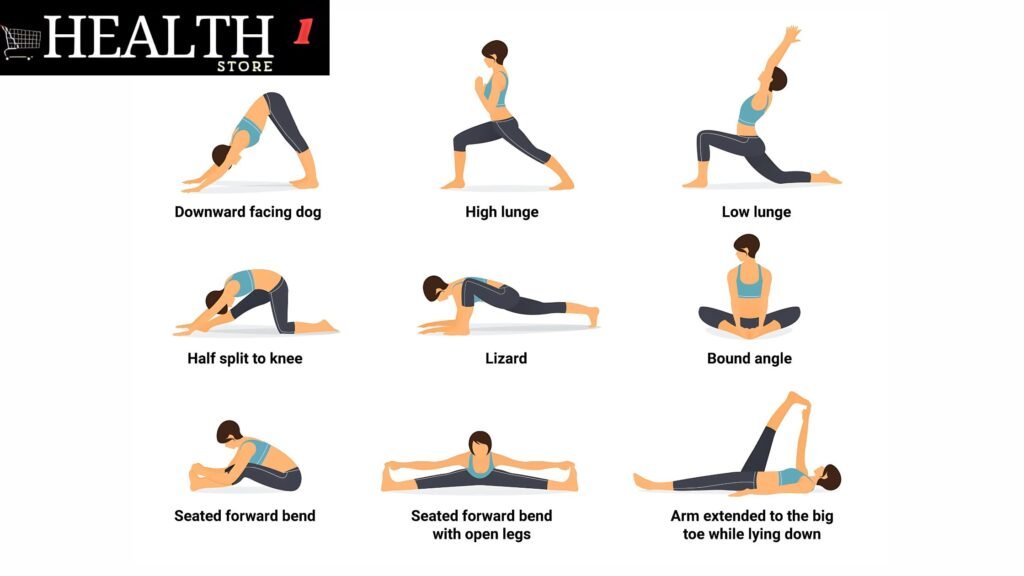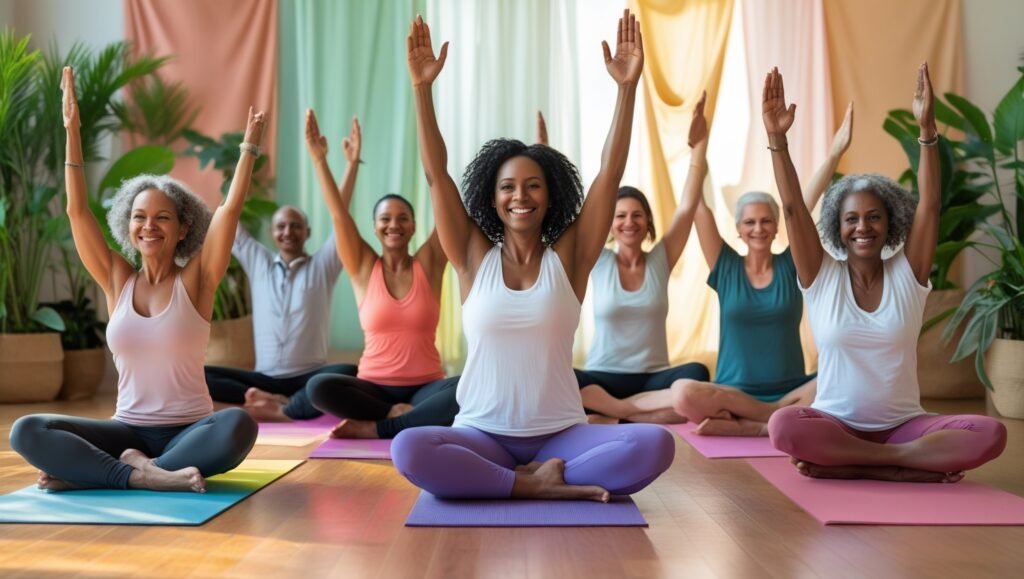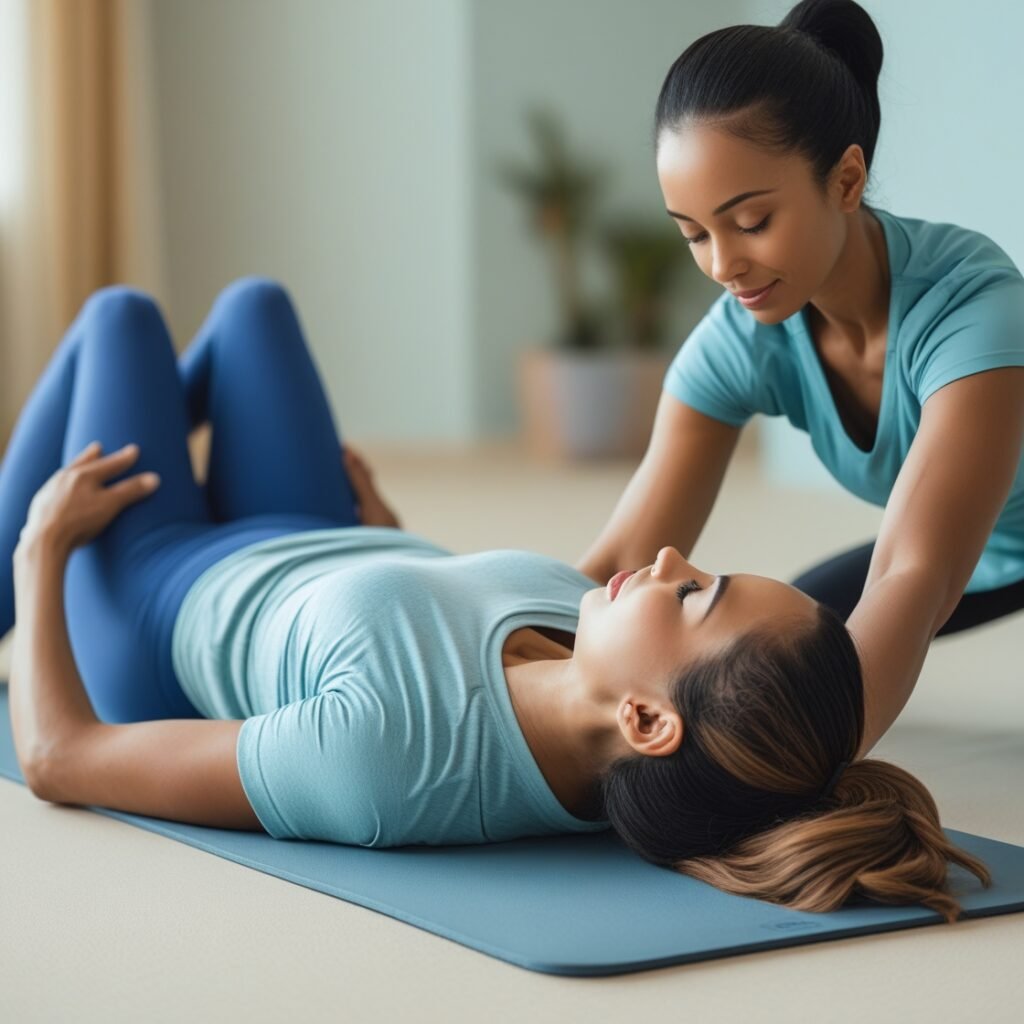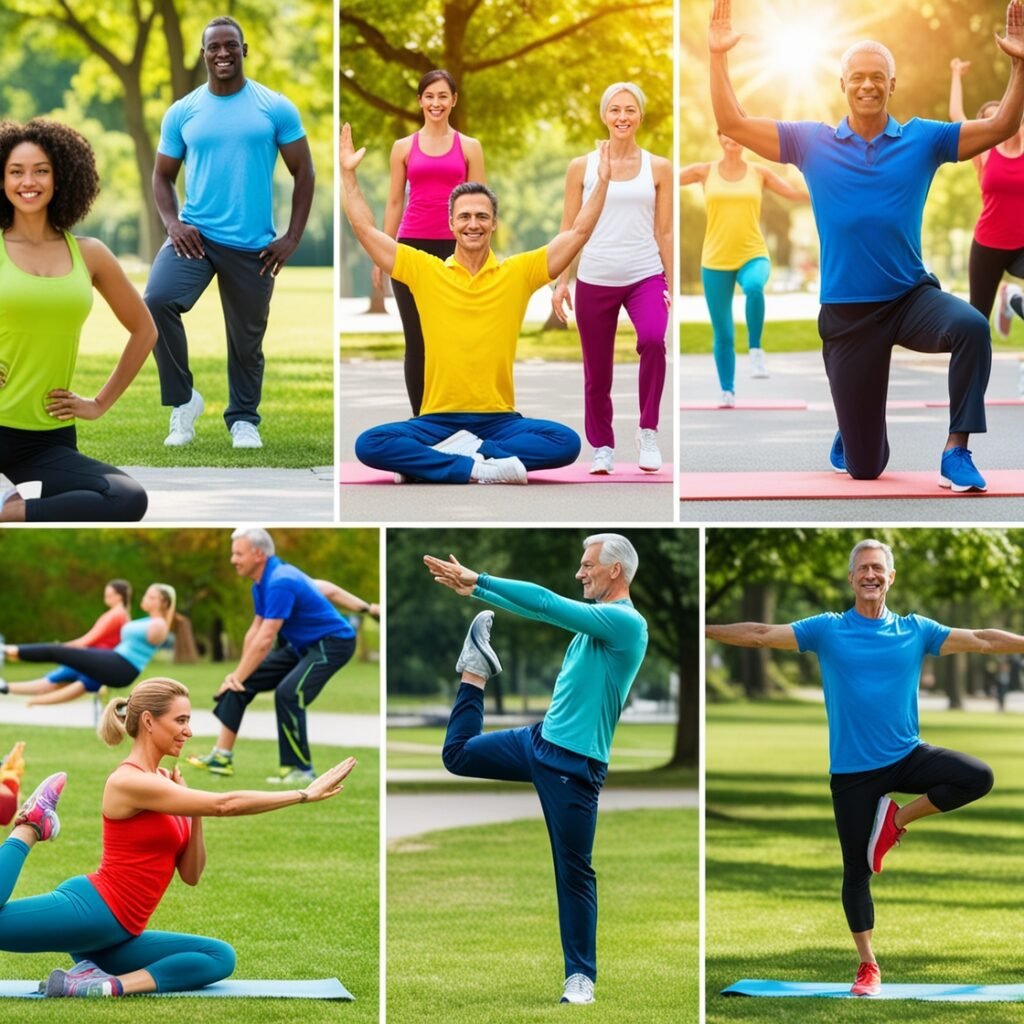Table of Contents
Introduction
Have you ever felt like your body is constantly tight, no matter how much you stretch or move? Or maybe you’ve wondered why some people seem to glide through their workouts with ease while you struggle with stiffness and discomfort. What if there was a way to unlock your body’s full potential, improve your flexibility, and say goodbye to muscle tension for good? Enter stretch therapy—a revolutionary approach to mobility and recovery that’s gaining traction among athletes, fitness enthusiasts, and even those who spend their days at a desk.
In this blog, we’ll dive deep into the world of stretch therapy, exploring what it is, how it works, and why it might just be the missing piece in your wellness routine. Whether you’re looking to enhance your athletic performance, recover faster, or simply move through life with less pain, this guide will provide you with the insights and tools you need to get started. Ready to transform the way you think about stretching? Let’s begin!

What is Stretch Therapy?
Have you ever wondered why traditional stretching sometimes leaves you feeling like you’re not making progress? Or why, despite your best efforts, certain muscles still feel tight and restricted? Stretch therapy might just be the answer you’ve been searching for. But what exactly is it, and how does it differ from the stretches you’re already familiar with?
At its core, stretch therapy is a targeted, systematic approach to improving flexibility, mobility, and overall muscle function. Unlike traditional stretching, which often involves holding a position for a set amount of time, stretch therapy combines techniques from physical therapy, yoga, and sports science to create a more dynamic and effective experience. It’s not just about loosening tight muscles—it’s about retraining your body to move more efficiently and with less strain.
Key Principles of Stretch Therapy
- Personalization: Every body is unique, and stretch therapy is tailored to address your specific needs, whether you’re an athlete, a desk worker, or someone recovering from an injury.
- Active Engagement: Instead of passively holding a stretch, you’re often guided to actively participate, engaging specific muscles to deepen the stretch and improve neuromuscular coordination.
- Holistic Approach: Stretch therapy doesn’t just focus on isolated muscles; it considers how your entire body works together, addressing imbalances and improving overall movement patterns.
How It Differs from Traditional Stretching
While traditional stretching can be beneficial, it often falls short in addressing deeper issues like muscle imbalances or chronic tightness. Stretch therapy, on the other hand, is designed to:
- Target the Root Cause: Instead of just alleviating symptoms, it aims to identify and correct the underlying issues causing stiffness or pain.
- Enhance Mind-Body Connection: By incorporating breathwork and mindful movement, stretch therapy helps you become more aware of how your body moves and feels.
- Deliver Lasting Results: Through consistent practice, stretch therapy can lead to long-term improvements in flexibility, posture, and overall mobility.
The Science Behind Stretch Therapy
So, what makes stretch therapy so effective? It’s rooted in the science of how muscles, fascia, and the nervous system interact. When done correctly, stretch therapy can:
- Improve Blood Flow: Enhanced circulation helps deliver nutrients to your muscles, speeding up recovery.
- Release Tension: By targeting connective tissue (fascia), it helps release stubborn knots and tightness.
- Boost Flexibility: Over time, your muscles and joints adapt, allowing for a greater range of motion.
Whether you’re dealing with chronic pain, looking to enhance your athletic performance, or simply want to move through life with more ease, stretch therapy offers a science-backed solution. Ready to dive deeper into its benefits? Let’s explore how this practice can transform your body and mind.
Read our blog about stretching exercises.
Benefits of Stretch Therapy
What if you could move more freely, recover faster, and feel less pain—all by incorporating one simple practice into your routine? That’s the power of stretch therapy. But what makes it so transformative? Let’s break down the key benefits that make this practice a game-changer for so many people.
1. Improved Flexibility and Range of Motion
Do you ever feel like your body is stuck in a limited range of motion, no matter how much you stretch? Stretch therapy goes beyond surface-level stretching to target deeper muscle layers and connective tissues. Over time, this helps:
- Increase Joint Mobility: Say goodbye to stiff hips, shoulders, and knees.
- Enhance Muscle Elasticity: Your muscles become more pliable, allowing for smoother, more fluid movements.
- Unlock New Movements: Whether it’s touching your toes or perfecting a yoga pose, stretch therapy helps you achieve what once felt impossible.
2. Relief from Muscle Tension and Pain
Tight muscles and chronic pain can feel like a never-ending battle. Stretch therapy offers a solution by:
- Releasing Knots and Trigger Points: Targeted techniques help alleviate stubborn tension in areas like the neck, back, and hips.
- Reducing Stress on Joints: By improving muscle flexibility, you’ll experience less strain on your joints during daily activities or workouts.
- Promoting Relaxation: The mindful, slow-paced nature of stretch therapy helps calm your nervous system, reducing overall stress and tension.
3. Enhanced Athletic Performance and Recovery
For athletes and fitness enthusiasts, stretch therapy is a secret weapon. It can:
- Boost Performance: Greater flexibility and mobility translate to better form, power, and efficiency in your sport or workout.
- Speed Up Recovery: By improving blood flow and reducing muscle soreness, stretch therapy helps you bounce back faster after intense training.
- Prevent Injuries: Addressing muscle imbalances and tightness reduces the risk of strains, sprains, and other common injuries.
4. Better Posture and Alignment
Slouching at your desk or hunching over your phone can take a toll on your posture. Stretch therapy helps correct these imbalances by:
- Lengthening Tight Muscles: Tight chest, hip flexors, and hamstrings are common culprits of poor posture. Stretch therapy targets these areas to restore balance.
- Strengthening Weak Muscles: By improving muscle coordination, it helps you maintain proper alignment throughout the day.
- Reducing Back and Neck Pain: Better posture means less strain on your spine, leading to fewer aches and pains. You can know more about neck pain exercises.
5. Mental and Emotional Well-Being
The benefits of stretch therapy aren’t just physical—they extend to your mental health, too. By incorporating breathwork and mindfulness, it can:
- Reduce Stress and Anxiety: The calming nature of the practice helps quiet your mind and promote relaxation.
- Improve Focus and Clarity: A relaxed body often leads to a clearer, more focused mind.
- Boost Confidence: As you see improvements in your flexibility and movement, you’ll feel more empowered in your body.
Whether you’re an athlete, a desk worker, or someone simply looking to feel better in your own skin, stretch therapy offers a wide range of benefits that can transform how you move and feel. Ready to explore who can benefit from this practice? Let’s dive into the next section!
Who Can Benefit from Stretch Therapy?
Is stretch therapy just for athletes or yoga enthusiasts, or can anyone reap its rewards? The truth is, this practice is incredibly versatile and can benefit a wide range of individuals—regardless of age, fitness level, or lifestyle. Whether you’re dealing with chronic pain, looking to improve your mobility, or simply want to feel better in your body, stretch therapy has something to offer. Let’s explore who can benefit most from this transformative practice.
1. Athletes and Fitness Enthusiasts
If you’re someone who pushes your body to its limits, stretch therapy can be a game-changer. It helps:
- Enhance Performance: Greater flexibility and mobility mean better form, power, and efficiency in your sport or workout.
- Speed Up Recovery: By improving blood flow and reducing muscle soreness, you’ll bounce back faster after intense training sessions.
- Prevent Injuries: Addressing muscle imbalances and tightness reduces the risk of strains, sprains, and other common injuries.
2. Office Workers and Sedentary Individuals
Spending hours at a desk can lead to tight hips, stiff shoulders, and poor posture. Stretch therapy offers relief by:
- Releasing Tension: Targeted stretches can alleviate tightness in the neck, shoulders, and lower back caused by prolonged sitting.
- Improving Posture: By lengthening tight muscles and strengthening weak ones, it helps you sit and stand taller with less strain.
- Boosting Energy: Gentle, mindful movement can counteract the sluggishness that often comes with a sedentary lifestyle.
3. Seniors and Those with Mobility Issues
As we age, maintaining flexibility and mobility becomes increasingly important. Stretch therapy can help seniors and individuals with limited mobility by:
- Increasing Range of Motion: Gentle stretches can make everyday activities like bending, reaching, and walking easier.
- Reducing Pain: Alleviating stiffness in joints and muscles can lead to less discomfort and a better quality of life.
- Improving Balance: Enhanced flexibility and coordination can reduce the risk of falls and injuries.
4. Individuals Recovering from Injuries
If you’re on the mend from an injury, stretch therapy can play a key role in your recovery. It helps:
- Restore Mobility: Gentle, targeted stretches can help regain lost range of motion in affected areas.
- Reduce Scar Tissue: Techniques like myofascial release can improve tissue elasticity and reduce stiffness.
- Prevent Re-Injury: By addressing imbalances and improving overall movement patterns, it lowers the risk of future injuries.
5. Anyone Seeking Stress Relief
In today’s fast-paced world, stress can take a toll on both your body and mind. Stretch therapy offers a calming escape by:
- Promoting Relaxation: The slow, mindful nature of the practice helps quiet your nervous system and reduce stress.
- Improving Sleep: By releasing physical tension, it can lead to better sleep quality and overall well-being.
- Enhancing Mindfulness: Incorporating breathwork and body awareness helps you stay present and grounded.
6. People with Chronic Pain Conditions
For those dealing with conditions like arthritis, fibromyalgia, or chronic back pain, stretch therapy can provide much-needed relief. It helps:
- Alleviate Pain: Gentle stretches can reduce muscle tension and improve joint mobility, leading to less discomfort.
- Improve Functionality: By enhancing flexibility and strength, it makes daily activities easier and less painful.
- Boost Mood: Reducing physical pain often leads to improved mental and emotional well-being.
No matter where you are in your health and fitness journey, stretch therapy has the potential to transform how you move and feel. Ready to explore the techniques that make this practice so effective? Let’s dive into the next section!
Common Stretch Therapy Techniques
Ever wondered what makes stretch therapy so effective? It’s not just about stretching—it’s about using proven techniques to target specific areas of your body, improve flexibility, and enhance overall mobility. Whether you’re working with a therapist or practicing on your own, understanding these techniques can help you get the most out of your stretch therapy sessions. Let’s explore some of the most common and effective methods.

1. Passive Stretching with a Therapist
Passive stretching is one of the foundational techniques in stretch therapy. Here’s how it works:
- What It Is: A therapist gently moves your body into a stretch while you remain relaxed.
- Why It’s Effective: It allows for a deeper stretch without activating the stretch reflex, which can limit your range of motion.
- Best For: Beginners, those recovering from injuries, or anyone looking to improve flexibility safely.
2. Active Isolated Stretching (AIS)
Active Isolated Stretching, or AIS, is a dynamic technique that involves active participation. Here’s what you need to know:
- What It Is: You actively move a muscle into a stretch, hold it for 1-2 seconds, and then release. This is repeated several times.
- Why It’s Effective: It improves flexibility while also strengthening the opposing muscles, creating a balanced approach to mobility.
- Best For: Athletes, fitness enthusiasts, and anyone looking to enhance performance and recovery.
3. Proprioceptive Neuromuscular Facilitation (PNF)
PNF is a highly effective technique that combines stretching and contracting muscles. Here’s the breakdown:
- What It Is: You stretch a muscle, contract it against resistance (often provided by a therapist), and then stretch it again.
- Why It’s Effective: It leverages the nervous system to increase flexibility and improve muscle coordination.
- Best For: Advanced practitioners, athletes, and those recovering from injuries.
4. Myofascial Release
Tight fascia (the connective tissue surrounding muscles) can limit mobility and cause pain. Myofascial release addresses this issue:
- What It Is: Gentle, sustained pressure is applied to release tension in the fascia.
- Why It’s Effective: It improves tissue elasticity, reduces pain, and enhances overall movement.
- Best For: Individuals with chronic pain, tight muscles, or restricted mobility.
5. Dynamic Stretching
Dynamic stretching involves movement-based stretches that prepare your body for activity. Here’s why it’s so useful:
- What It Is: Controlled movements that take your muscles through their full range of motion, such as leg swings or arm circles.
- Why It’s Effective: It increases blood flow, warms up the muscles, and improves functional mobility.
- Best For: Pre-workout routines or anyone looking to improve dynamic flexibility.
6. Assisted Stretching
Assisted stretching combines elements of passive stretching and active participation. Here’s how it works:
- What It Is: A therapist or partner helps you achieve a deeper stretch by providing gentle assistance.
- Why It’s Effective: It allows you to go beyond your usual range of motion while maintaining control and safety.
- Best For: Those looking to deepen their stretches or target hard-to-reach areas.
7. Breathwork and Mindfulness
While not a stretching technique per se, breathwork and mindfulness are integral to stretch therapy. Here’s why:
- What It Is: Using controlled breathing and mental focus to enhance the effectiveness of stretches.
- Why It’s Effective: It helps relax the nervous system, reduce tension, and improve mind-body connection.
- Best For: Anyone looking to reduce stress and enhance the overall benefits of stretching.
By incorporating these techniques into your routine, you can unlock the full potential of stretch therapy. Whether you’re working with a professional or practicing at home, these methods offer a pathway to greater flexibility, reduced pain, and improved overall well-being. Ready to learn how to incorporate stretch therapy into your daily life? Let’s move on to the next section!
How to Incorporate Stretch Therapy into Your Routine
So, you’re convinced that stretch therapy can transform your flexibility, reduce pain, and enhance your overall well-being—but where do you start? Incorporating stretch therapy into your routine doesn’t have to be complicated or time-consuming. With a few simple steps, you can make it a seamless part of your day, whether you’re a busy professional, a fitness enthusiast, or someone just starting their wellness journey. Let’s dive into how you can get started and stay consistent.
1. Find a Qualified Stretch Therapist
If you’re new to stretch therapy, working with a professional can help you learn the basics and ensure you’re doing it safely. Here’s how to find the right therapist:
- Look for Certifications: Seek out therapists with credentials in stretch therapy, physical therapy, or related fields.
- Read Reviews: Check online reviews or ask for recommendations from friends or fitness professionals.
- Schedule a Consultation: Many therapists offer initial consultations to discuss your goals and assess your needs.
You can Check stretch lab for more help.
2. Start with a Simple DIY Routine
Don’t have access to a therapist? No problem! You can begin stretch therapy at home with these beginner-friendly tips:
- Focus on Major Muscle Groups: Start with stretches for your hamstrings, hips, shoulders, and back.
- Use Props: Yoga blocks, straps, or even a towel can help you achieve deeper stretches safely.
- Follow Online Guides: There are plenty of free videos and tutorials to guide you through basic stretches.
3. Create a Consistent Schedule
Consistency is key to reaping the benefits of stretch therapy. Here’s how to make it a habit:
- Set a Time: Dedicate 10-15 minutes each day to stretching, whether it’s in the morning, during a lunch break, or before bed.
- Pair It with Other Activities: Stretch while watching TV, listening to a podcast, or even during work breaks.
- Track Your Progress: Keep a journal to note improvements in flexibility, pain levels, or overall mobility.
4. Combine Stretch Therapy with Other Wellness Practices
To maximize the benefits, consider pairing stretch therapy with other healthy habits:
- Staying hydrated: Drinking plenty of water helps keep your muscles and connective tissues supple.
- Move Regularly: Incorporate light movement, like walking or yoga, to complement your stretching routine.
- Practice Mindfulness: Pair your stretches with deep breathing or meditation to enhance relaxation and focus.
5. Listen to Your Body
One of the most important aspects of stretch therapy is tuning in to your body’s signals. Here’s how to do it:
- Avoid Overstretching: Stretch to the point of mild tension, not pain.
- Adjust as Needed: Modify stretches based on how your body feels each day.
- Rest When Necessary: If you’re sore or fatigued, give your body time to recover.
6. Gradually Increase Intensity
As you become more comfortable with stretch therapy, you can challenge yourself with more advanced techniques:
- Incorporate Props: Use resistance bands or foam rollers to deepen your stretches.
- Try New Techniques: Experiment with PNF stretching or myofascial release for added benefits.
- Set Goals: Whether it’s touching your toes or improving your posture, having clear goals can keep you motivated.
7. Make It Enjoyable
The more you enjoy your stretch therapy routine, the more likely you are to stick with it. Here’s how to make it fun:
- Play Music: Create a playlist of calming or energizing tunes to accompany your stretches.
- Stretch with Friends: Turn it into a social activity by stretching with a partner or joining a group class.
- Celebrate Progress: Acknowledge and celebrate small wins, like increased flexibility or reduced pain.
By following these steps, you can seamlessly integrate stretch therapy into your daily life and start experiencing its transformative benefits. Ready to explore some frequently asked questions about this practice? Let’s move on to the next section!

Frequently Asked Questions About Stretch Therapy
Curious about stretch therapy but still have some burning questions? You’re not alone! This practice is gaining popularity, and it’s natural to wonder how it works, who it’s for, and whether it’s worth your time. To help you out, we’ve compiled answers to some of the most common questions about stretch therapy. Let’s clear up the confusion and give you the clarity you need to take the next step.
1. Is Stretch Therapy Safe for Everyone?
Absolutely! Stretch therapy is generally safe for people of all ages and fitness levels. However, there are a few exceptions:
- Injuries or Medical Conditions: If you have an acute injury, chronic condition, or recent surgery, consult your doctor or a qualified therapist before starting.
- Pregnancy: While gentle stretching can be beneficial during pregnancy, certain techniques may need to be modified. Always seek guidance from a professional.
- Beginners: If you’re new to stretching, start slowly and consider working with a therapist to ensure proper form.
2. How Often Should I Practice Stretch Therapy?
The frequency of your stretch therapy sessions depends on your goals and lifestyle. Here’s a general guide:
- For Maintenance: 2-3 sessions per week can help maintain flexibility and reduce tension.
- For Improvement: If you’re looking to increase flexibility or recover from an injury, aim for 4-5 sessions per week.
- For Busy Schedules: Even 10-15 minutes daily can make a noticeable difference over time.
3. Can Stretch Therapy Replace Other Forms of Exercise?
While stretch therapy offers incredible benefits, it’s not a replacement for other types of exercise. Think of it as a complement to your routine:
- Cardio and Strength Training: These activities build endurance and muscle, while stretch therapy improves flexibility and recovery.
- Yoga or Pilates: These practices often incorporate stretching, but stretch therapy provides a more targeted approach to mobility.
- Balance: A well-rounded fitness routine includes a mix of cardio, strength, flexibility, and recovery practices.
Read this article about yoga for core strength.
4. How Long Does It Take to See Results?
Patience is key! While some people notice improvements after just a few sessions, lasting results take time. Here’s what to expect:
- Short-Term: You may feel more relaxed and less tense immediately after a session.
- Medium-Term: Within 2-4 weeks, you’ll likely notice increased flexibility and reduced pain.
- Long-Term: After 6-8 weeks of consistent practice, you’ll see significant improvements in mobility, posture, and overall well-being.
5. Do I Need Special Equipment for Stretch Therapy?
Not at all! While props like yoga blocks, straps, or foam rollers can enhance your practice, they’re not necessary to get started. Here’s what you can use:
- At Home: A towel, pillow, or even a wall can serve as helpful tools.
- With a Therapist: They’ll provide any equipment needed during your sessions.
- On the Go: You can practice simple stretches anywhere—no equipment required.
6. Can I Do Stretch Therapy on My Own?
Yes, you can! While working with a therapist is ideal for beginners or those with specific needs, many stretch therapy techniques can be done independently. Here’s how to get started:
- Follow Online Tutorials: There are plenty of free resources to guide you.
- Start Slow: Focus on basic stretches and gradually incorporate more advanced techniques.
- Listen to Your Body: Avoid pushing yourself too hard and stop if you feel pain.
7. What’s the Difference Between Stretch Therapy and Yoga?
While both practices focus on flexibility and mindfulness, they have distinct differences:
- Stretch Therapy: More targeted and therapeutic, often guided by a professional to address specific issues.
- Yoga: A holistic practice that combines physical postures, breathwork, and meditation for overall well-being.
- Complementary: Many people find that combining the two offers the best of both worlds.
8. Can Stretch Therapy Help with Chronic Pain?
Yes, it can! Stretch therapy is particularly effective for managing chronic pain caused by:
- Muscle Tension: Releasing tight muscles can alleviate discomfort.
- Poor Posture: Correcting imbalances can reduce strain on your body.
- Injuries: Gentle stretching can aid in recovery and prevent further issues.
By addressing these common questions, we hope you feel more confident about exploring stretch therapy. Let’s dive into the final thoughts.
Conclusion
So, what’s stopping you from giving stretch therapy a try? Whether you’re an athlete looking to enhance performance, a desk worker battling stiffness, or someone simply seeking relief from chronic pain, this practice offers a pathway to greater flexibility, mobility, and overall well-being. From debunking common myths to exploring its wide-ranging benefits, we’ve covered everything you need to know to get started—and thrive—on your stretch therapy journey.
Remember, stretch therapy isn’t just about touching your toes or achieving perfect splits. It’s about reconnecting with your body, releasing tension, and moving through life with more ease and confidence. Whether you’re working with a therapist or practicing at home, the key is consistency, mindfulness, and a willingness to listen to your body.
As you embark on this journey, keep in mind that progress takes time. Celebrate the small wins—whether it’s feeling less tension in your shoulders, standing taller with better posture, or simply enjoying a moment of calm in your day. These incremental improvements add up, leading to lasting transformation.
So, why wait? Take the first step today. Roll out a mat, find a qualified therapist, or explore a beginner-friendly routine online. Your body—and mind—will thank you. Here’s to unlocking your full potential, one stretch at a time.
Ready to transform how you move and feel? The power of stretch therapy is within your reach. Let’s stretch toward a healthier, happier you!




